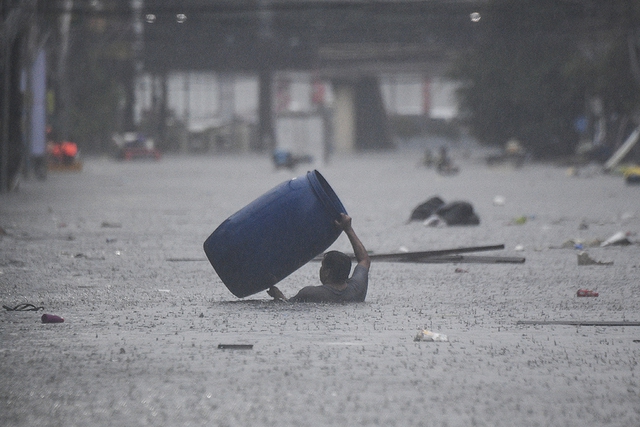While East Asia is struggling to cope with storms and floods, other parts of the world are suffering from scorching heat.
Storms raging
Yesterday, Typhoon Gaemi swept through the northern Philippines before making landfall on Taiwan and heading to mainland China. Rappler newspaper quoted the Philippine Meteorological Department’s announcement that the possibility of Gaemi strengthening to a super storm level cannot be ruled out before landing in Taiwan. The storm caused heavy rain in many areas on the main island of Luzon in the Philippines, in which many roads in the capital Manila were heavily flooded and impassable. Water levels in some rivers rose, causing houses to be flooded to the second floor, and schools in many areas were closed, according to the Inquirer newspaper. Statistics show that 12 people died in this country due to the storm.

In Taiwan, 21 cities and districts announced the closure of schools and offices on July 24. Railway operations were stopped from noon on July 24 while hundreds of flights were canceled. CNA quoted a notice from the island’s meteorological department as saying that as of noon on July 24, the storm had sustained winds of 184 km/h and gusts of up to 227 km/h. It is expected to be the strongest storm to make landfall. island for 8 years. More than 4,000 people were evacuated from mountainous areas at risk of landslides due to heavy rains. The Defense Agency instructed its 29,000 members to prepare to respond. Yesterday afternoon, one person was killed by a falling tree while nearly 60 others were injured due to the effects of the storm. In mainland China, the National Meteorological Center issued an orange warning for storm Gaemi on the morning of July 24, the second highest level in the 4-level warning system. China is experiencing a summer of harsh weather with heavy rain across the east and south, while the north is hit by successive heat waves.

In Ethiopia in Africa, heavy rains have also caused two landslide disasters since last weekend, killing 229 people and affecting more than 14,000 others.
Record high temperature
In a contrary development, tens of millions of people on the West Coast of the United States are suffering from scorching heat in recent days. Reuters cited information from the National Weather Service (NWS) predicting that temperatures in some places in Nevada could exceed 43 degrees Celsius at noon, while in the northern state of Montana the temperature could reach 41 degrees Celsius. The heat combined with dry air and wind has caused forest fires to spread over the past few days. In total, in the western US region, there are about 69 large fires. In Canada, forest fires in the town of Jasper in Alberta province forced more than 25,000 people to evacuate. Smoke and dust from the fires have been blown into parts of the western United States, causing air quality to seriously deteriorate.
In recent days, temperatures in Gulf countries have exceeded 60 degrees Celsius, while temperate regions in Europe have exceeded 45 degrees Celsius. Many cities in Japan, Indonesia and China also recorded heat. record. The European Union’s Copernicus weather monitoring agency yesterday announced that July 22 was the hottest day in history, with a global average surface air temperature of 17.15 degrees Celsius, the highest level since data was released. collected in 1940. It was also the second day in a row that the global temperature record was broken. Scientists believe that climate change is the cause of this phenomenon, but they are also surprised that new records continue to be set even though the extreme weather phenomenon El Nino has passed.





